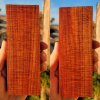Ive been coming to the same realization. As stacy (and ben i think) has said … when you have a large piece of wood, cut it to capture the grain/appearance of a few specific blocks/scales, not to maximize the sheer number of scales (i think stacy says he just burns the not-so-good pieces.
I think that observation will also help us understand the reason for the cost of really nice looking scales..
This is a bit of why handle grade material is so pricy. For wood figure to be good in an area about ~1.75 × 5.5 inches you need some incredible figure. In my experience if you have less than 4 or 5 curls per inch it won't work for handles.
Most wood retailers would list that has being top tier figure/ mastergrade/ whatever.
But if you want something to look great at the scale of a knife you need to get into the 10-20 curls per inch range and that figure is just exponentially more rare. Super dense burl and curl figure is not only rare, but it needs to be clean and solid.
Figure of all sorts is a type of defect. Burl, birdseye, curly, these all induce stresses in the wood and stresses cause cracks, voids, ingrown bark, twists and all the other imperfections of wood. So you're talking about a rare figure, without voids, properly dried and prepared.
To go from a log or a burl or other raw wood to a clean, high quality, solid block of wood has a ton of waste, it takes work, it takes time, it takes good connections with suppliers, and it takes a lot of experience earned through expensive mistakes.





